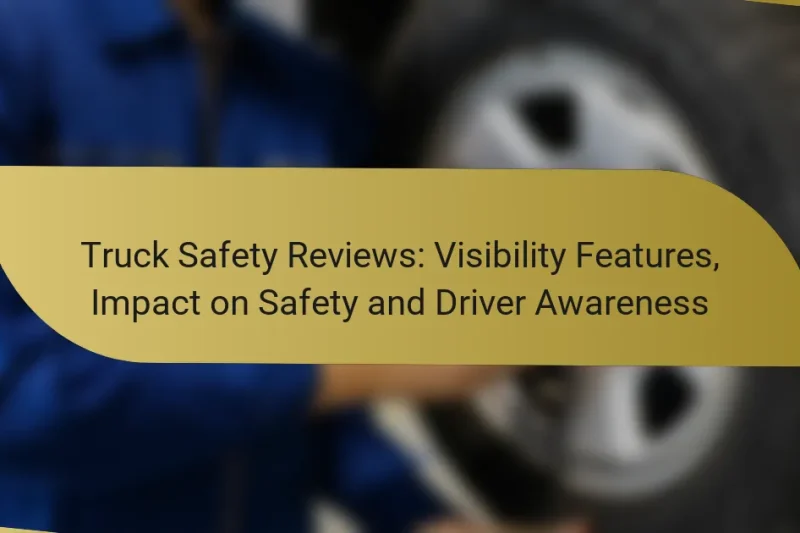Truck safety reviews focus on advanced features that significantly enhance driver awareness and accident prevention. Technologies … Truck Safety Reviews: Advanced Features, Performance Metrics and User ExperienceRead more
Truck Safety Reviews: Essential Features
Truck safety reviews highlight the importance of essential features that enhance vehicle control and prevent accidents. By integrating advanced technologies, these safety systems provide real-time feedback to drivers, significantly improving road safety. Additionally, trucks equipped with such features can lead to lower insurance premiums, as they reduce the risk of accidents and potential claims.
Truck Safety Reviews: Purchase Influence, Safety Ratings and Customer Feedback
Truck safety reviews play a crucial role in shaping consumer purchase decisions by offering essential insights … Truck Safety Reviews: Purchase Influence, Safety Ratings and Customer FeedbackRead more
Truck Safety Reviews: Visibility Features, Impact on Safety and Driver Awareness
Truck safety is greatly enhanced by visibility features that improve driver awareness and reduce blind spots. … Truck Safety Reviews: Visibility Features, Impact on Safety and Driver AwarenessRead more
Truck Safety Reviews: Budget-Friendly Options, Essential Features and Safety Ratings
When searching for budget-friendly trucks, safety should be a top priority. The best options combine affordability … Truck Safety Reviews: Budget-Friendly Options, Essential Features and Safety RatingsRead more
Truck Safety Reviews: New Driver Considerations, Essential Features and Safety Ratings
For new truck drivers, prioritizing safety features is crucial for ensuring a secure driving experience. Essential … Truck Safety Reviews: New Driver Considerations, Essential Features and Safety RatingsRead more
Truck Safety Reviews: Anti-Lock Braking Systems, Performance and Reliability
Anti-lock braking systems (ABS) are crucial for enhancing truck safety by preventing wheel lock-up during hard … Truck Safety Reviews: Anti-Lock Braking Systems, Performance and ReliabilityRead more
Truck Safety Reviews: Long-Distance Features, Essential Technologies and Driver Comfort
Long-distance trucking requires a focus on safety features that enhance driver awareness and vehicle control, thereby … Truck Safety Reviews: Long-Distance Features, Essential Technologies and Driver ComfortRead more
What are the essential features of truck safety systems?
Essential features of truck safety systems include advanced technologies designed to enhance vehicle control and prevent accidents. These systems work together to provide real-time feedback and assistance to drivers, ultimately improving overall safety on the road.
Advanced braking systems
Advanced braking systems, such as automatic emergency braking (AEB), detect potential collisions and apply the brakes if the driver does not respond in time. These systems can significantly reduce stopping distances and prevent accidents, especially in urban environments where sudden stops are common.
When considering advanced braking systems, look for features like adaptive cruise control, which adjusts speed based on traffic conditions, and anti-lock braking systems (ABS) that maintain steering control during hard braking. Regular maintenance is crucial to ensure these systems function correctly.
Lane departure warning systems
Lane departure warning systems alert drivers when they unintentionally drift out of their lane, helping to prevent side-swipe collisions. These systems often use cameras to monitor lane markings and provide visual or audible warnings.
Some systems also include lane-keeping assist, which actively steers the vehicle back into the lane if the driver does not respond. It’s important to note that while these systems enhance safety, they should not replace attentive driving.
Blind spot monitoring
Blind spot monitoring systems use sensors to detect vehicles in adjacent lanes that may not be visible to the driver. When a vehicle is detected in the blind spot, the system typically provides visual or auditory alerts to warn the driver before changing lanes.
For optimal effectiveness, ensure that the sensors are clean and properly calibrated. It’s also beneficial to combine this technology with safe driving practices, such as checking mirrors and looking over your shoulder before lane changes.
Electronic stability control
Electronic stability control (ESC) helps prevent skidding and loss of control by automatically applying brakes to individual wheels when it detects a loss of traction. This feature is particularly useful in adverse weather conditions or during sudden maneuvers.
ESC is now a standard requirement in many countries, including the United States and European Union, making it an essential feature for modern trucks. Regularly check that the system is functioning properly, as it can be crucial for maintaining vehicle stability.
Collision avoidance technology
Collision avoidance technology encompasses various systems designed to prevent accidents by detecting potential hazards and assisting the driver in avoiding them. This can include features like forward collision warning, which alerts the driver of an impending collision, and adaptive cruise control that adjusts speed to maintain a safe following distance.
When evaluating collision avoidance systems, consider how they integrate with other safety features and their effectiveness in different driving conditions. Regular software updates may also enhance the performance of these systems, so staying informed about manufacturer updates is advisable.
How do truck safety features impact insurance rates?
Truck safety features significantly influence insurance rates by reducing risk and potential claims. Insurers often reward vehicles equipped with advanced safety systems with lower premiums, reflecting the decreased likelihood of accidents.
Lower premiums for advanced safety systems
Trucks that incorporate advanced safety systems, such as automatic braking, lane departure warnings, and collision avoidance technology, typically enjoy lower insurance premiums. Insurers recognize that these features can prevent accidents, leading to fewer claims and lower costs for them.
For example, a truck equipped with multiple safety technologies might see premiums reduced by 10-20% compared to a model without such features. It’s advisable to inquire about specific discounts when purchasing or renewing insurance policies.
Insurance discounts for fleet safety compliance
Fleets that adhere to safety compliance standards, such as regular maintenance checks and driver training programs, can qualify for significant insurance discounts. Insurers often evaluate the overall safety record of the fleet, which can lead to lower rates for compliant operations.
Implementing a robust safety program can yield discounts ranging from 5-15%, depending on the insurer and the extent of compliance. Fleet managers should document safety practices and communicate them to their insurance providers to maximize potential savings.
What are the best truck models for safety in the United States?
Some of the best truck models for safety in the United States include the Volvo VNL series, Freightliner Cascadia, and Kenworth T680. These models are recognized for their advanced safety features, robust construction, and compliance with stringent safety regulations.
Volvo VNL series
The Volvo VNL series is renowned for its commitment to safety, featuring a strong chassis and advanced driver assistance systems. Key safety elements include lane departure warning, collision avoidance technology, and adaptive cruise control, which help reduce the risk of accidents.
Additionally, the VNL series is designed with a focus on driver comfort, which can lead to better concentration and reduced fatigue. The ergonomic cab layout and visibility enhancements contribute to a safer driving experience.
Freightliner Cascadia
The Freightliner Cascadia is another top contender in truck safety, equipped with features like the Detroit Assurance suite, which includes emergency braking and blind spot monitoring. These technologies are designed to assist drivers in avoiding potential hazards on the road.
Moreover, the Cascadia’s aerodynamic design not only improves fuel efficiency but also enhances stability, making it safer during adverse weather conditions. Regular maintenance and adherence to safety protocols further ensure its reliability on the road.
Kenworth T680
The Kenworth T680 stands out for its robust safety features, including advanced braking systems and a strong frame designed to withstand impacts. Its safety technologies, such as lane keeping assist and adaptive cruise control, help drivers maintain control in various driving conditions.
In addition to its safety features, the T680 offers a comfortable driving environment, which can help reduce stress and improve focus. Ensuring that the truck is regularly serviced and equipped with the latest safety technology is crucial for maximizing its safety potential.
How to choose a truck with optimal safety features?
To choose a truck with optimal safety features, focus on evaluating safety ratings, manufacturer reputation, and specific technologies that enhance protection. Prioritize models that meet or exceed industry standards for crashworthiness and driver assistance systems.
Evaluate safety ratings from NHTSA
The National Highway Traffic Safety Administration (NHTSA) provides safety ratings that assess a vehicle’s crash performance. Look for trucks with a 4 or 5-star overall rating, as these indicate better safety records in various crash tests.
Consider the specific ratings for frontal crash, side crash, and rollover resistance. A truck with high ratings across all categories is generally a safer choice. You can find this information on the NHTSA website or through dealership resources.
Consider manufacturer safety reputation
Research the safety reputation of the truck’s manufacturer, as this can influence the reliability of safety features. Brands known for prioritizing safety often invest in advanced technologies and rigorous testing.
Look for customer reviews, industry awards, and historical recall data related to safety issues. A manufacturer with a strong safety track record is more likely to produce trucks equipped with effective safety features.
What regulations govern truck safety in North America?
Truck safety in North America is primarily governed by federal and state regulations aimed at ensuring safe operation and maintenance of commercial vehicles. Key regulatory bodies include the Federal Motor Carrier Safety Administration (FMCSA) and the Department of Transportation (DOT), which establish standards for drivers, vehicles, and operational practices.
FMCSA safety regulations
The FMCSA sets forth a comprehensive framework of safety regulations that apply to commercial trucking operations. These regulations cover various aspects, including driver qualifications, hours of service, vehicle maintenance, and safety inspections. Compliance with these regulations is crucial for reducing accidents and ensuring the safety of both drivers and the public.
For instance, the FMCSA mandates that drivers maintain a log of their hours to prevent fatigue, which is a significant factor in many truck accidents. Regular vehicle inspections and maintenance are also required to ensure that trucks are in safe operating condition.
DOT compliance requirements
The DOT enforces compliance requirements that complement FMCSA regulations, focusing on the safe transportation of goods. These requirements include vehicle registration, insurance coverage, and adherence to weight limits. Each state may have additional regulations that align with federal standards but also address local concerns.
Truck operators must ensure their vehicles are registered and insured according to DOT guidelines, which helps protect against liability in case of accidents. Additionally, understanding and adhering to weight limits is essential to prevent damage to roads and ensure vehicle stability.
How do truck safety features evolve with technology?
Truck safety features are continuously evolving due to advancements in technology, improving both driver and road safety. Innovations such as collision avoidance systems, lane departure warnings, and adaptive cruise control are becoming standard in modern trucks, significantly reducing accident rates.
Integration of AI in safety systems
Artificial Intelligence (AI) is increasingly integrated into truck safety systems to enhance decision-making and predictive capabilities. AI algorithms analyze vast amounts of data from sensors and cameras to identify potential hazards and provide real-time feedback to drivers.
For example, AI can detect obstacles in the truck’s path and alert the driver or even initiate automatic braking. This proactive approach not only helps prevent accidents but also assists in optimizing driving patterns for fuel efficiency.
Future trends in autonomous safety technology
Future trends in autonomous safety technology for trucks include the development of fully autonomous driving systems and advanced vehicle-to-vehicle communication. These technologies aim to create a network of connected vehicles that can share information about road conditions and traffic, further enhancing safety.
As regulations evolve, we may see more trucks equipped with Level 4 autonomy, where vehicles can operate without human intervention in specific conditions. However, the transition will require rigorous testing and adherence to safety standards to ensure public trust and regulatory compliance.






